

Exploring our past to sort out myth from reality
Share this Page on
Facebook or Twitter

These are the voyages of the TimeShip Anachron.
Our Mission: To boldly explore the past, dispelling
mythinformation and mythconceptions
of American History along the way.
 Visit us on Facebook
Visit us on Facebook
Meet MythAmerica Series

Pt 1 Pt 2 Pt 3 Pt 4 Pt 5 Pt 6 Pt 7 Pt 8 Pt 9
Terrorism on American Soil, Part 4
“Is the Whole World on Fire?”
At the end of the previous entry in this series, masses of white Tulsans began gathering and making plans to “storm” the negro community of Greenwood “at daybreak” on June 1, 1921.
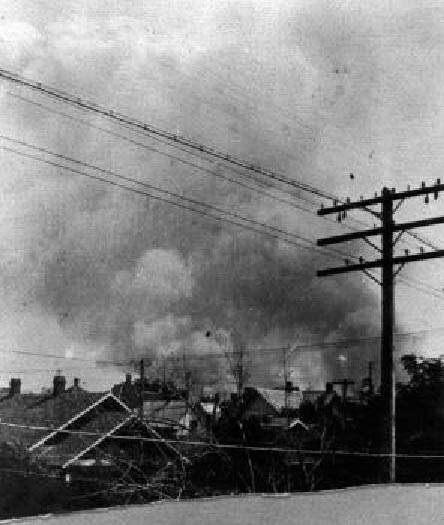
Sweeping past the black business district, now aflame, the white rioters entered the heart of Tulsa’s African-
An officer in the local “Tulsa Guard” contacted the head of the Oklahoma National Guard at 12:35 AM and requested troops be sent to deal with the situation. Unfortunately, the request needed to be signed by the chief of police, the county sheriff, and a local judge. It wasn’t easy to fulfill this legal requirement…Sheriff McCullough was still barricaded with his men and Rowland on the top floor of the Courthouse! Somehow this roadblock was solved, and:
… at 1:46 a.m., the needed telegram arrived at the state capital. It read:
WESTERN UNION TELEGRAM
Tulsa, Okla
June l, 1921
Governor J.B.A. Robertson Oklahoma City, Oklahoma. Race riot developed here. Several killed. Unable handle situation. Request that National Guard forces be sent by special train. Situation serious.
Twenty-
Tulsa’s longest night would finally be ending, but its longest day would have only begun. [SOURCE: unless otherwise noted, all quotations in this entry are from this source.].
Actually, there were “local” National Guard troops stationed in Tulsa. As you will see below, from the point of view of the citizens of Greenwood, they quickly became among their tormentors, rather than in any sense guarding their safety or their rights. The request above was for “State Troops” of the Oklahoma National Guard to be sent in, men who would be much more highly trained and professional—and impartial. Once they arrived, the game totally changed…but they didn’t arrive for many hours.
The train wasn’t even leaving Oklahoma City until 5 AM. By the time it arrived at 9:15 AM…it was far too late in the game to change the outcome, other than that they likely prevented more deaths, and helped restore some semblance of order to the area.
But I’m getting ahead of the story…
In the pre-
Smaller bands of whites also had been active. One group hauled a machine gun to the top of the Middle States Milling Company’s grain elevator off of First Street, and set it up to fire to the north of Greenwood Avenue. Shortly before daybreak, five white men in a green Franklin automobile pulled up alongside the crowd of whites who were massed behind the Frisco freight depot. “What the hell are you waitin’ on?,” one of the men hollered, “let’s go get ‘em.” But the crowd would not budge, and the men in the car set off alone toward Deep Greenwood. Their bodies, and the bullet-
Across the tracks in Greenwood, considerable activity also had been taking place. While some black Tulsans prepared themselves to face the onslaught, others decided that it was time to go. “About this time officers Pack and Lewis pushed up to us and said it would not be safe for us to remain any longer,” recalled Mrs. Dimple Bush, who was with her husband at the Red Wing Hotel. “So,” she added, “We rushed out and found a taxi which took us straight north on Greenwood.”
Not far away, along North Elgin, Julia Duff, a teacher at Booker T. Washington High School, faced a similar crisis. Awakened by loud voices outside of her rented room shortly before dawn, the young teacher was soon nearly overcome with fear. As later described in a letter published in the Chicago Defender:
“Mrs. S. came into her room and told her to dress-
“She said her legs gave way from under her,” the letter continued, “and she had to crawl about the room, taking things from her closet, putting them in her trunk, for she thought if anything happened she’d have her trunk packed, and before she got everything in they heard footsteps on their steps and there were six out there and they ordered Mr. Smart to march, hands up, out of the house.”
And finally the attack began in earnest.
Several eyewitnesses later recalled that when dawn came at 5:08 a.m. that morning, an unusual whistle or siren sounded, perhaps as a signal for the mass assault on Greenwood to begin. Although the source of this whistle or siren is still unknown, moments later, the white mobs made their move. While the machine gun in the grain elevator opened fire, crowds of armed whites poured across the Frisco tracks, headed straight for the African American commercial district. As later described by one eyewitness:
“With wild frenzied shouts, men began pouring from behind the freight depot and the long string of boxcars and evidently from behind the piles of oil well easing which was at the other end and on the north side of the building. From every place of shelter up and down the tracks came screaming, shouting men to join in the rush toward the Negro section. Mingled with the shouting were a few rebel-
Many first-
…had sat up much of the night, uncertain of what to do. “Finally,” she later wrote,
“My friend, Mrs. Jones, called her husband, who was trying to take a little rest. They decided to try to make for a place of safety, so called to me that they were leaving. By this time the enemy was close upon us, so they ran out of the south door, which led out onto Archer Street, and went east toward Lansing. I took my little girl, Florence Mary, by the hand and fled out of the west door on Greenwood. I did not take time to get a hat for myself or Baby, but started out north on Greenwood, running amidst showers of bullets from the machine gun located in the granary and from men who were quickly surrounding our district. Seeing that they were fighting at a disadvantage, our men had taken shelter in the buildings and in other places out of sight of the enemy. When my daughter, Florence Mary, and I ran into the street, it was vacant for a block or more. Someone called to me to “Get out of the street with that child or you both will be killed.” I felt that it was suicide to remain in the building, for it would surely be destroyed and death in the street was preferred, for we expected to be shot down at any moment. So we placed our trust in God, our Heavenly Father, who seeth and knoweth all things, and ran out of Greenwood in the hope of reaching a friend’s home who lived over the Standpipe Hill in Greenwood Addition.”
A lady named Dimple Bush described her experience in fleeing from Greenwood:
“It was just dawn; the machine guns were sweeping the valley with their murderous fire and my heart was filled with dread as we sped along,” she recalled, “Old women and men, children were running and screaming everywhere.”
And then the situation took a surreal turn. Up in the sky… not a bird…not Superman…no, World War I biplanes! For there were at least a dozen or so such planes, owned by companies and by individuals, at the local airport. And some of these were pressed into service for the situation.
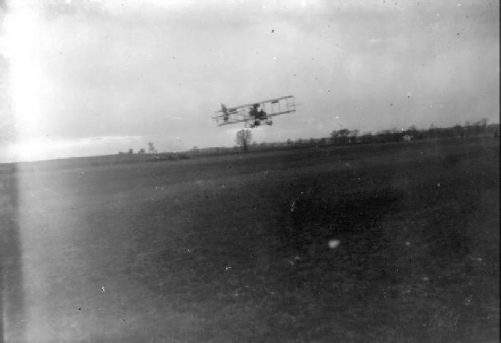
Soon, however, new perils developed. As the mobs of armed whites rushed into the southern end of the African American district, airplanes — manned by whites — also appeared overhead. As Dr. R.T. Bridgewater, a well-
“Shortly after we left a whistle blew. The shots rang from a machine gun located on Standpipe Hill near my residence and aeroplanes began to fly over us, in some instances very low to the ground. A cry was heard from the women saying, “Look out for the aeroplanes, they are shooting upon us.”
Numerous other eyewitnesses –both black and white — confirm the presence of an unknown number of airplanes flying over Greenwood during the early daylight hours of June 1. … there is little doubt but that some of the occupants of the airplanes fired upon black Tulsans with pistols and rifles.
Moreover, there is evidence, to suggest that men in at least one airplane dropped some form of explosives, probably sticks of dynamite, upon a group of African American refugees as they were fleeing the city.
Surreality continued. Concentration camps were set up! Yes, that word was actually used. Although some referred to them as “internment centers” and implied their purpose was to keep negroes in “protective custody” for their own safety, the descriptions of events surely belie that:
As the waves of white rioters descended upon the African American district, a deadly pattern soon emerged.
First, the armed whites broke into the black homes and businesses, forcing the occupants out into the street, where they were led away at gunpoint to one of a growing number of internment centers.
One of the main centers was Convention Hall in the north part of Tulsa, not far south of Greenwood.
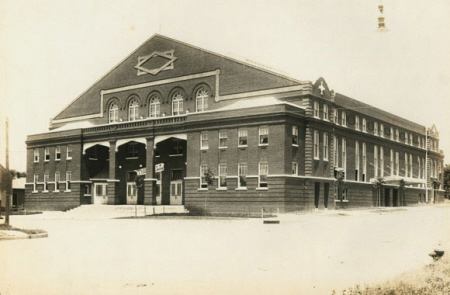
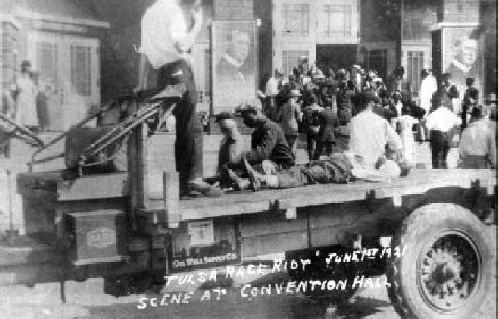
Anyone who resisted was shot. Moreover, African American men in homes where firearms were discovered met the same fate. Next, the whites looted the homes and businesses, pocketing small items, and hauling away larger items either on foot or by car or truck. Finally, the white rioters then set the homes and other buildings on fire, using torches and oil-
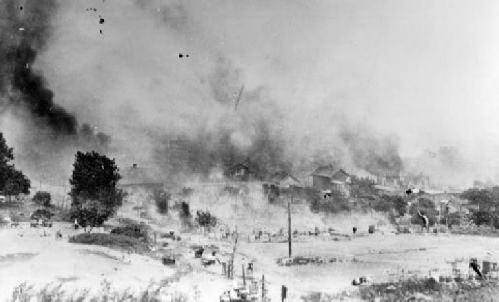
The looting and burning of African -
As if that was not enough…
Atrocities occurred along the way. According to one account, published ten days after the riot in a Chicago newspaper,
“Another cruel instance was when they [white rioters] went to the home of an old couple and the old man, 80 years old, was paralyzed and sat in a chair and they told him to march and he told them he was crippled, but he’d go if someone would take him, and they told his wife (old, too) to go, but she didn’t want to leave him, and he told her to go on anyway. As she left one of the damn dogs shot the old man and then they fired the house.”
And of course no one of any age escaped the atrocities:
After armed whites had led his mother away at gunpoint, five-
It wasn’t just civilian marauders involved in the atrocities.
According to black Deputy Sheriff V.B. Bostic, a white Tulsa police officer “drove him and his wife from his home,”‘ and then “poured oil on the floor and set a lighted match to it.”
Deputy Sheriff Bostic was not, however, the only eyewitness to report acts of criminal misconduct by Tulsa police officers during the course of the riot. According to one white eyewitness, a “uniformed [white] policeman on East Second Street went home, changed his uniform to plainclothes, and went to the Negro district and led a bunch of whites into Negro, houses, some of the bunch pilfering, never offered to protect men, women or children, or property.” This particular account was buttressed by the testimony of an African American witness, who reported that he had seen the same officer in question “on the morning of the riot, June 1, kicking in doors of Negro homes, and assisting in the destruction of property.”
The black men didn’t go down without a fight, of course, trying to defend their homes, families, businesses, and community. But obviously the odds were totally, completely, unalterably against them.
Despite the daunting odds against them, black Tulsans valiantly fought back. African American riflemen had positioned themselves in the belfry of the newly-
“In a couple of minutes pieces of brick started falling, then whole bricks began tumbling from the narrow slits in the cupola. Within five or six minutes the openings were large jagged holes with so many bricks flying from that side of the cupola wall that it seemed ready to fall.
“The men stopped firing the machine gun and almost immediately the houses on the outer rim of the area that had been protected by the snipers, became victims of the arsonists. We watched the men take the machine gun from the tripod, wrap it in a canvas cover then lay it on the bed of the truck. They rolled up the belts with the empty shell casings, put away those that were still unused, and in what seemed less than ten minutes from the time the truck was parked at the location, drove away.”
“While standing on the high ground where the machine gun had been firing, we watched the activity below for a few minutes. Most of the houses were beginning to burn and smoke ascended slowly in to the air while people flitted around as busy as bees down there. From the number that ran in and out of the houses and the church, there had evidently been a couple of hundred who remained behind when the mob bypassed the area.”
A short while later, Mount Zion was torched.
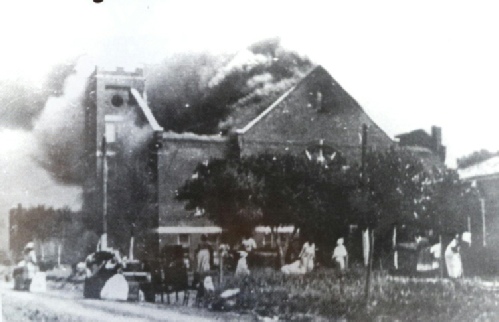
Dedicated only weeks before the riot, the Mount Zion Baptist Church was a great source of pride for many black Tulsans. But after a prolonged battle, the white rioters burned it-
And then there were the “local” Guardsmen.
Attempts by black Tulsans to defend their homes and property were undercut by the actions of both the Tulsa police and the local National Guard units, who, rather than focus on disarming and arresting the white rioters, took steps that led to the eventual imprisonment of practically all of the city’s African American citizens. Guardsmen deployed on Standpipe Hill made at least one eastward march in the early hours of June 1, rounding up African Americans along the way, before they were fired upon, apparently by whites as well as blacks, near Greenwood Avenue. The guardsmen then marched to Sunset Hill, where they handed over their black prisoners to local police officers.
An arrest by a white officer was not a guarantee of safety for black Tulsans. According to Thomas Higgins, a white resident of Wichita, Kansas who happened to be visiting Tulsa when the riot broke out, “I saw men of my own race, sworn officers, on three occasions search Negroes while their hands were up, and not finding weapons, extracted what money they found on them. If the Negro protested, he was shot.”
And not just crooked “officers of the law” took prisoners:
White civilians also took black prisoners. When the invasion began, Carrie Kinlaw, an African American woman who lived out toward the Section Line, had to run toward the fighting in order to help her sisters retrieve their invalid mother. Reaching the elderly woman in a “rain of bullets”, Kinlaw later wrote:
“My sisters and I gathered her up, placed her on a cot, and three of us carried the cot and the other one carried a bundle of clothes; thus we carried Mother about six blocks, with bullets falling on all sides. About six squads of rioters overtook us, asked for men and guns, made us hold up our hands.”
Not all of her captors, however, were adults. “There were boys in that bunch,” she added, “from about 10 years upward, all armed with guns.”
Below is a description by another victim of “civilian captors.” (Let us make this perfectly clear—instances such as these are not whites “arresting” armed insurgents who had been battling with them. They are white men taking into custody totally innocent, unarmed black men from their own homes and marching them away.)
James T. West a teacher at Booker T. Washington High School, was arrested by whites at his home on Easton Street that morning. “Some men appeared with drawn guns and ordered all of the men out of the house,” he recalled immediately after the riot.
“I went out immediately. They ordered me to raise my hands, after which three or four men searched me. They told me to line up in the street. I requested them to let me get my hat and best shoes, but they refused and abusively ordered me to line up. They refused to let one of the men put on any kind of shoes. After lining up some 30 or 40 of us men, they ran us through the streets to Convention Hall, forcing us to keep our hands in the air all the while. While we were running, some of the ruffians would shoot at our heels and swore at those who had difficulty keeping up. They actually drove a car into the bunch and knocked down two or three men.”
Harold M. Parker, a white bookkeeper for the Oklahoma Producing and Refining Corporation at the time of the riot, later corroborated how armed whites sometimes shot at the heels of their black prisoners. “Sometimes they missed and shot their legs,” Parker recalled a half century later, “It was sheer cruelty coming out.”
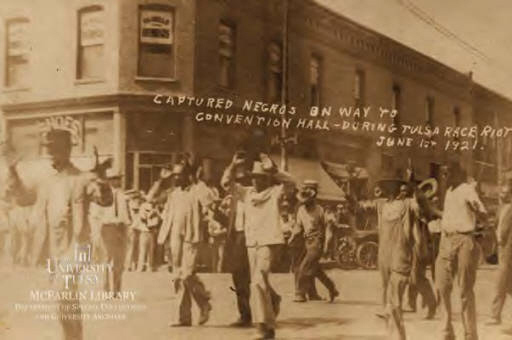
As the white mobs continued to move northward, into the heart of the black residential district, some of the worst violence of the riot appears to have taken place. “Negro men, women and children were killed in great numbers as they ran, trying to flee to safety,” one unidentified informant later told Mary E. Parrish, “. . . the most horrible scenes of this occurrence was to see women dragging their children while running to safety, and the dirty white rascals firing at them as they ran.”
The most tragic picture I have seen while researching this sordid incident was a close-
In the wake of the invasion came a wall of flame, steadily moving northward. “Is the whole world on fire?” asked a young playmate of eight-
Yes, sadly, that young child’s whole world was indeed on fire.
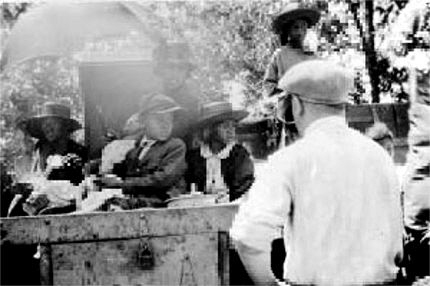
Any fleeing families were denied freedom by whites positioned on escape routes. (Courtesy Department of Special Collections, McFarlin Library, University of Tulsa).
Continue on to the next section in this series to read the conclusion to this ignominious saga in the history of America, The Sometimes-